Node.js实战一文带你开发博客项目(API 对接 MySQL)
Posted 前端杂货铺
tags:
篇首语:本文由小常识网(cha138.com)小编为大家整理,主要介绍了Node.js实战一文带你开发博客项目(API 对接 MySQL)相关的知识,希望对你有一定的参考价值。
个人简介
👀个人主页: 前端杂货铺
🙋♂️学习方向: 主攻前端方向,也会涉及到服务端
📃个人状态: 在校大学生一枚,已拿多个前端 offer(秋招)
🚀未来打算: 为中国的工业软件事业效力n年
🥇推荐学习:🍍前端面试宝典 🍉Vue2 🍋Vue3 🍓Vue2&Vue3项目实战 🥝Node.js
🌕个人推广:每篇文章最下方都有加入方式,旨在交流学习&资源分享,快加入进来吧
Node.js系列文章目录
| 内容 | 参考链接 |
|---|---|
| Node.js(一) | 初识 Node.js |
| Node.js(二) | Node.js——开发博客项目之接口 |
| Node.js(三) | Node.js——一文带你开发博客项目(使用假数据处理) |
| Node.js(四) | Node.js——开发博客项目之MySQL基础 |
文章目录
一、前言
前面我们已经使用了 假数据去处理路由接口,并学习了开发博客路由相关 MySQL的基础知识。
下面我们就可以 整合改进 这两部分,实现 API 和 MySQL 的对接 工作。
二、Node.js 连接 mysql
安装 MySQL
npm install mysql

在 src 目录下创建 ./conf/db.js 文件,用于连接数据库的配置

db.js 文件
- 线上环境与开发环境的配置是不一样的
- 这里写的是一样的,因为项目没有上线
// 获取环境参数, process 为 node.js 进程的一些信息
const env = process.env.NODE_ENV
// 配置
let MYSQL_CONF
// 开发环境下
if (env === 'dev')
MYSQL_CONF =
host: 'localhost',
user: 'root',
password: '1234abcd',
port: '3306',
database: 'myblog'
// 线上环境下
if (env === 'production')
MYSQL_CONF =
host: 'localhost',
user: 'root',
password: '1234abcd',
port: '3306',
database: 'myblog'
// 导出共享
module.exports =
MYSQL_CONF
在 src 目录下创建 ./db/mysql.js 文件,用于存放一些数据

mysql.js 文件
- 引入 mysql 和连接数据库
- 封装 sql 函数,用于统一执行
// 引入 MySQL
const mysql = require('mysql')
// 引入数据库连接配置
const MYSQL_CONF = require('../conf/db')
// 创建连接对象
const con = mysql.createConnection(MYSQL_CONF)
// 开始连接
con.connect()
// 统一执行 sql 的函数
function exec(sql)
const promise = new Promise((resolve, reject) =>
con.query(sql, (err, result) =>
if (err)
reject(err)
return
resolve(result)
)
)
return promise
// 导出共享
module.exports =
exec
三、API 对接 MySQL
1、文件目录
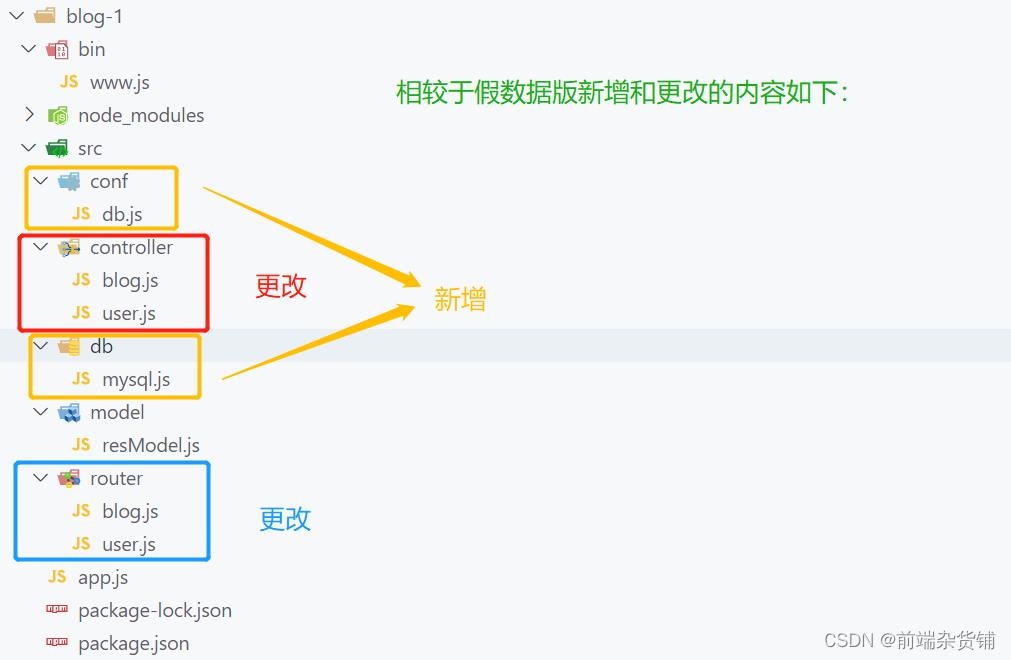
2、控制器_controller
blog.js 文件
- blog 相关 sql 逻辑
- 返回的是 promise 实例
// 导入执行 sql 的相关内容
const exec = require('../db/mysql')
// 获取博客列表(通过作者和关键字)
const getList = (author, keyword) =>
// 1=1 是为了语法的绝对正确,注意以下 sql 拼接时的空格
let sql = `select * from blogs where 1=1 `
if (author)
sql += `and author='$author' `
if (keyword)
sql += `and title like '%$keyword%' `
// 以时间的倒序
sql += `order by createtime desc;`
// 返回 promise
return exec(sql)
// 获取博客详情(通过 id)
const getDetail = (id) =>
const sql = `select * from blogs where id='$id'`
return exec(sql).then(rows =>
// 返回数组的对象
return rows[0]
)
// 新建博客 newBlog 若没有,就给它一个空对象
const newBlog = (blogData = ) =>
// blogData 是一个博客对象,包含 title content author 属性
const title = blogData.title
const content = blogData.content
const author = blogData.author
const createTime = Date.now()
// sql 插入语句
const sql = `
insert into blogs (title, content, createtime, author)
values ('$title', '$content', '$createTime', '$author');
`
return exec(sql).then(insertData =>
console.log('insertData is ', insertData)
return
id: insertData.insertId
)
// 更新博客(通过 id 更新)
const updateBlog = (id, blogData = ) =>
// id 就是要更新博客的 id
// blogData 是一个博客对象 包含 title content 属性
const title = blogData.title
const content = blogData.content
const sql = `
update blogs set title='$title', content='$content' where id=$id
`
return exec(sql).then(updateData =>
// console.log('updateData is ', updateData)
// 更新的影响行数大于 0,则返回 true
if (updateData.affectedRows > 0)
return true
return false
)
// 删除博客(通过 id 删除)
const delBlog = (id, author) =>
const sql = `delete from blogs where id='$id' and author='$author'`
return exec(sql).then(delData =>
if (delData.affectedRows > 0)
return true
return false
)
// 导出共享
module.exports =
getList,
getDetail,
newBlog,
updateBlog,
delBlog
user.js 文件
- 登录相关 sql 逻辑
- 返回的是 promise 实例
const exec = require('../db/mysql')
// 登录(通过用户名和密码)
const loginCheck = (username, password) =>
const sql = `
select username, realname from users where username='$username' and password='$password'
`
return exec(sql).then(rows =>
return rows[0] ||
)
// 导出共享
module.exports =
loginCheck
3、路由_router
blog.js 文件
- 博客相关路由
- 调用控制器中的方法
// 导入博客和用户控制器相关内容
const getList, getDetail, newBlog, updateBlog, delBlog = require('../controller/blog')
// 导入成功和失败的模型
const SuccessModel, ErrorModel = require('../model/resModel')
// blog 相关路由
const handleBlogRouter = (req, res) =>
const method = req.method // GET/POST
const id = req.query.id // 获取 id
// 获取博客列表 GET 请求
if (method === 'GET' && req.path === '/api/blog/list')
// 博客的作者,req.query 用在 GET 请求中
const author = req.query.author || ''
// 博客的关键字
const keyword = req.query.keyword || ''
// 查询的结果
const result = getList(author, keyword)
return result.then(listData =>
return new SuccessModel(listData)
)
// 获取博客详情 GET 请求
if (method === 'GET' && req.path === '/api/blog/detail')
// 获取博客详情数据
const result = getDetail(id)
// 创建并返回成功模型的 promise 实例对象
return result.then(data =>
return new SuccessModel(data)
)
// 新建一篇博客 POST 请求
if (method === 'POST' && req.path === '/api/blog/new')
// 假数据,待开发登录时再改成真实数据
req.body.author = 'zhangsan'
// req.body 用于获取请求中的数据(用在 POST 请求中)
const result = newBlog(req.body)
// 创建并返回成功模型的 promise 实例对象
return result.then(data =>
return new SuccessModel(data)
)
// 更新一篇博客
if (method === 'POST' && req.path === '/api/blog/update')
// 传递两个参数 id 和 req.body
const result = updateBlog(id, req.body)
return result.then(val =>
if (val)
return new SuccessModel()
else
return new ErrorModel('更新博客失败')
)
// 删除一篇博客
if (method === 'POST' && req.path === '/api/blog/del')
// 假数据,待开发登录时再改成真实数据
const author = 'zhangsan'
const result = delBlog(id, author)
return result.then(val =>
if (val)
return new SuccessModel()
else
return new ErrorModel('删除博客失败')
)
// 导出
module.exports = handleBlogRouter
user.js 文件
- 用户登录相关路由
- 调用控制器中的方法
// 导入用户登录内容
const loginCheck = require('../controller/user')
// 导入成功和失败的模板
const SuccessModel, ErrorModel = require('../model/resModel')
// user 路由
const handleUserRouter = (req, res) =>
const method = req.method
// 登录
if (method === 'POST' && req.path === '/api/user/login')
const username, password = req.body
// 传入两个参数 用户名 密码
const result = loginCheck(username, password)
return result.then(data =>
if (data.username)
return new SuccessModel()
return new ErrorModel('登录失败')
)
// 导出共享
module.exports = handleUserRouter
四、各个接口的测试
查询博客列表

通过关键字查询博客(模糊查询)

通过关键字查询博客(精准查询)

通过id获取博客详情

通过 ApiPost/Postman 工具测试 新建博客

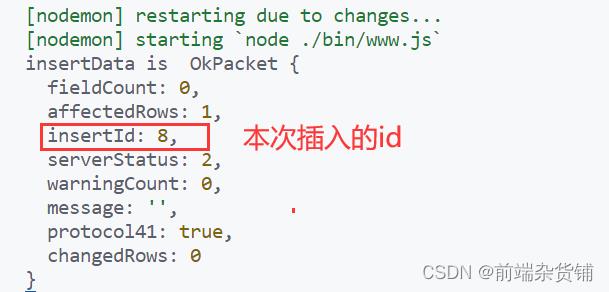
通过 ApiPost/Postman 工具测试 更新博客
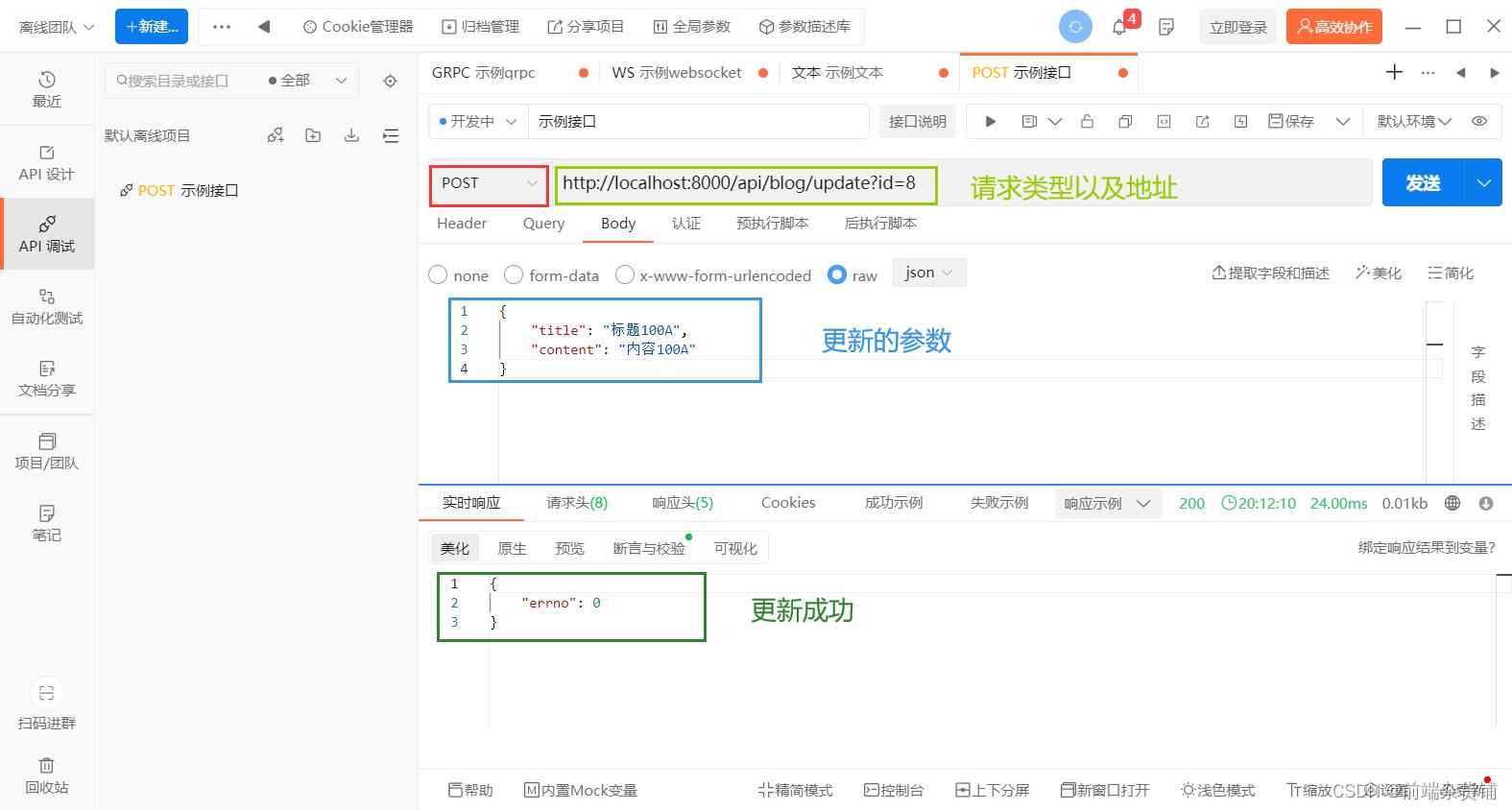
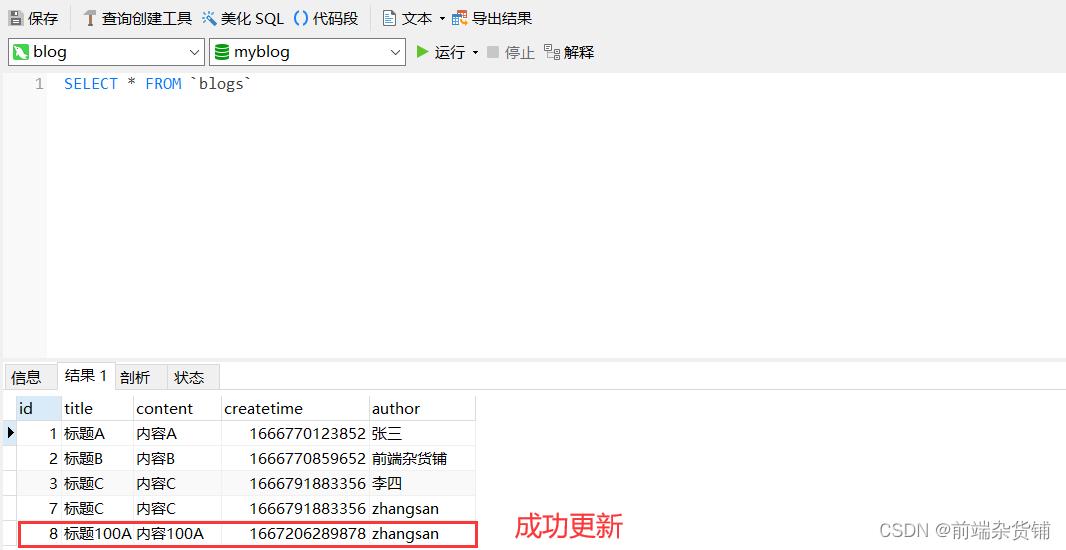
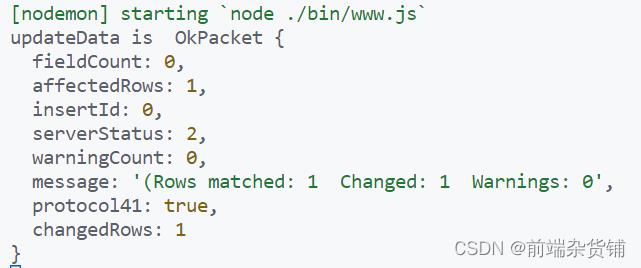
通过 ApiPost/Postman 工具测试 删除博客
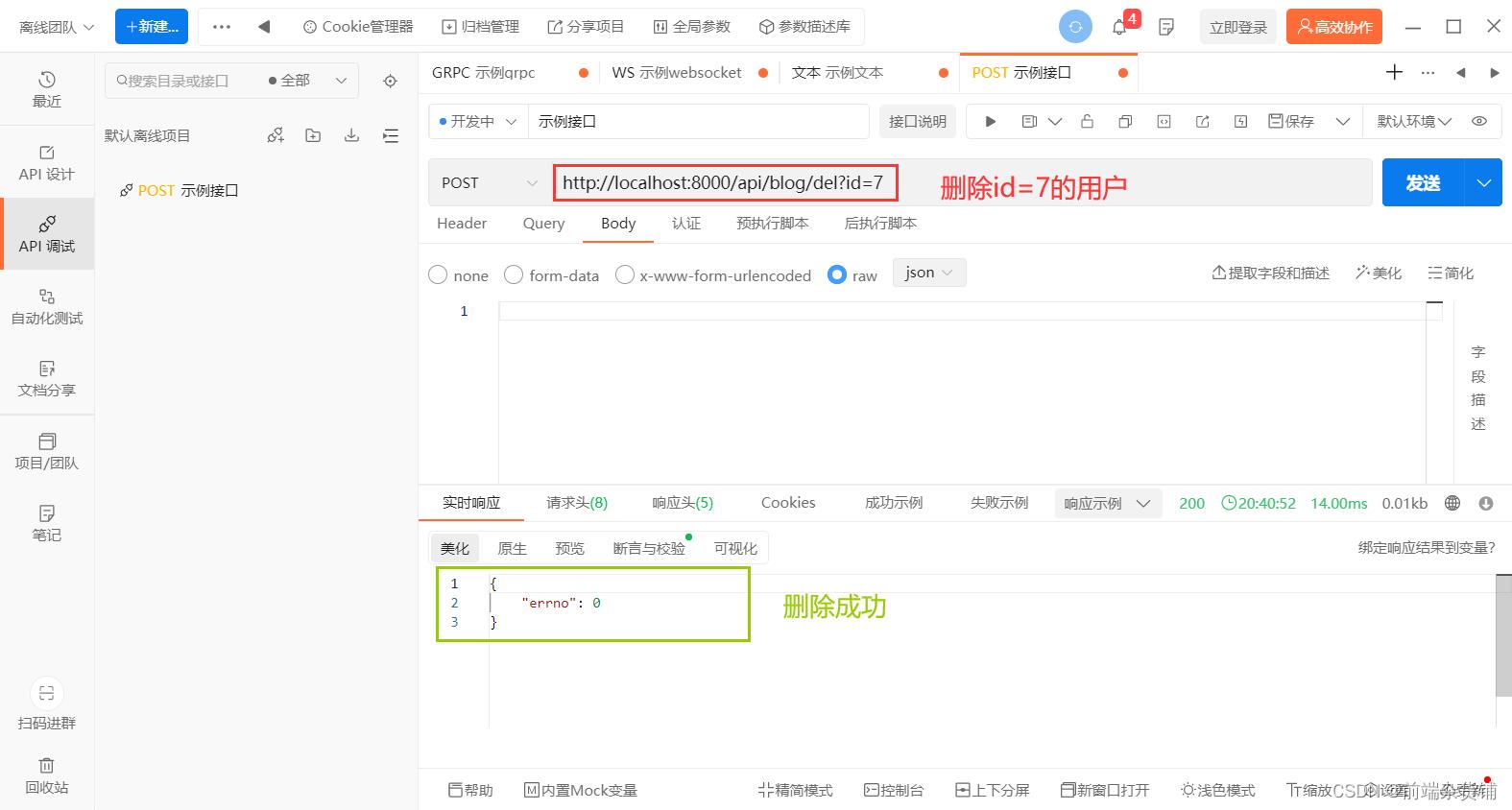
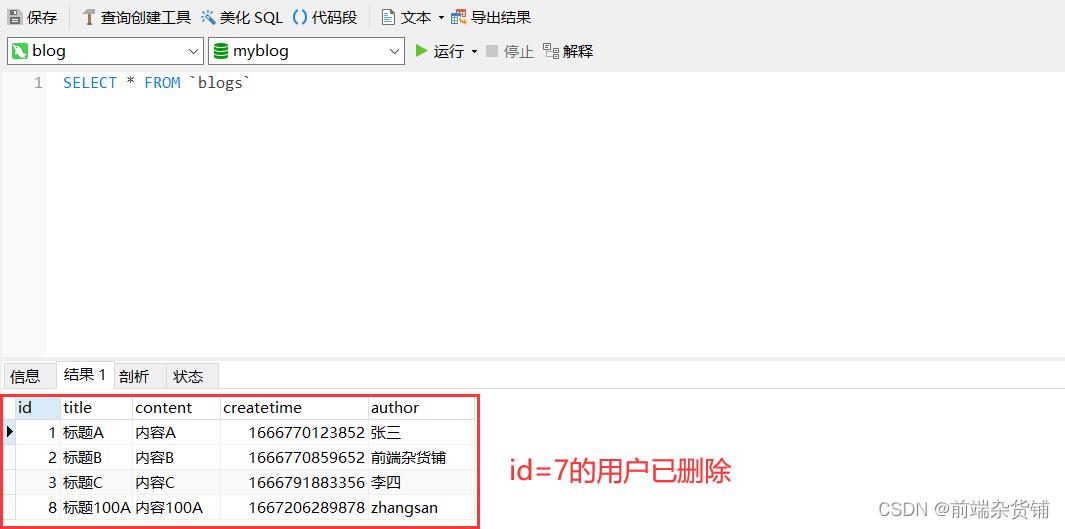
通过 ApiPost/Postman 工具测试 登录
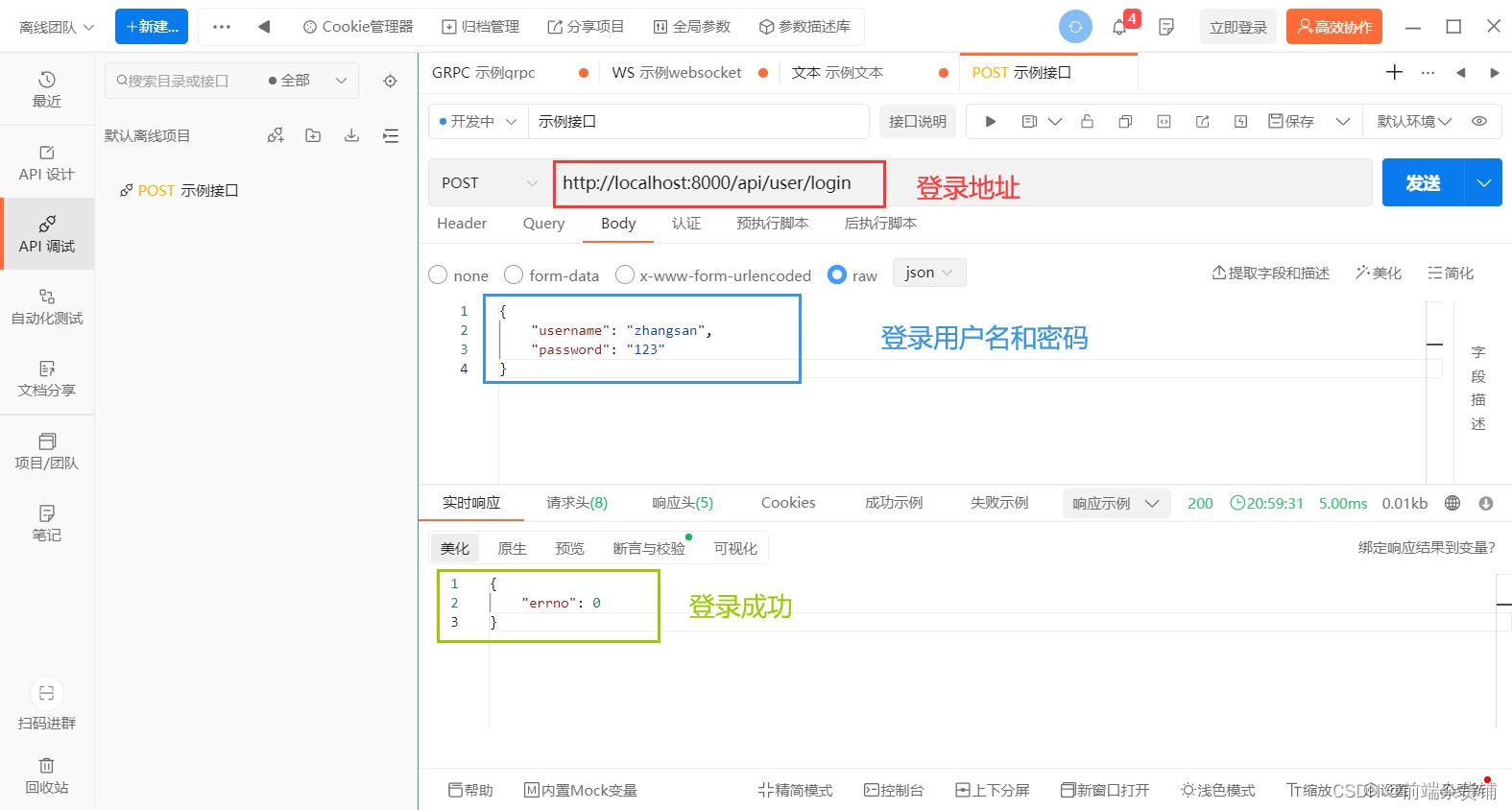
四、写在最后(附源码)
至此,开发博客的项目(API 对接 MySQL)就完成了。
后续会对该项目进行多次重构【多种框架(express,koa)和数据库(mysql,sequelize,mongodb)】
如果你需要该项目的 源码,请通过本篇文章最下面的方式 加入 进来~~

Node.js实战一文带你开发博客项目(使用假数据处理)
个人简介
👀个人主页: 前端杂货铺
🙋♂️学习方向: 主攻前端方向,也会涉及到服务端
📃个人状态: 在校大学生一枚,已拿 offer(秋招)
🥇推荐学习:🍍前端面试宝典 🍉Vue2 🍋Vue3 🍓Vue2&Vue3项目实战 🥝Node.js
🌕个人推广:每篇文章最下方都有加入方式,旨在交流学习&资源分享,快加入进来吧
Node.js系列文章目录
| 内容 | 参考链接 |
|---|---|
| Node.js(一) | 初识 Node.js |
| Node.js(二) | Node.js——开发博客项目之接口 |
文章目录
一、前言
2022-10-24,首先祝大家节日快乐,工作和学习中再无 bug~~
本文 开发博客项目的接口,是使用的 假数据 处理的。
后续 的文章还会使用 各种框架和数据库进行重构,敬请期待~
该项目的 开发模式,是 常规通用 的方式,所以学习这种 层次渐进的开发模式 也是很有意义的!
二、博客项目实现
1、文件目录
项目开发的层次感:
www.js(第一层)——> app.js(第二层)——> ./router(第三层)——> ./controller(第四层)
第一层:项目执行的地方
第二层:一些配置,请求响应头,格式化,promise实例等
第三层:路由接口,只关心路由,不管深层次的逻辑
第四层:只关心数据的地方
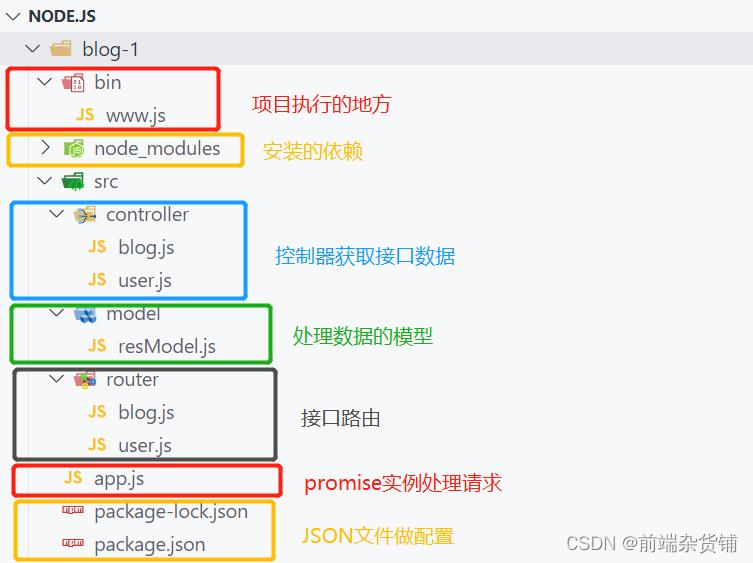
2、环境配置
初始化 package.json(配置相关文件)
npm init -y
安装依赖(安装相关依赖文件)
npm install
安装 nodemon(自动重启服务)
npm install nodemon cross-env --save-dev
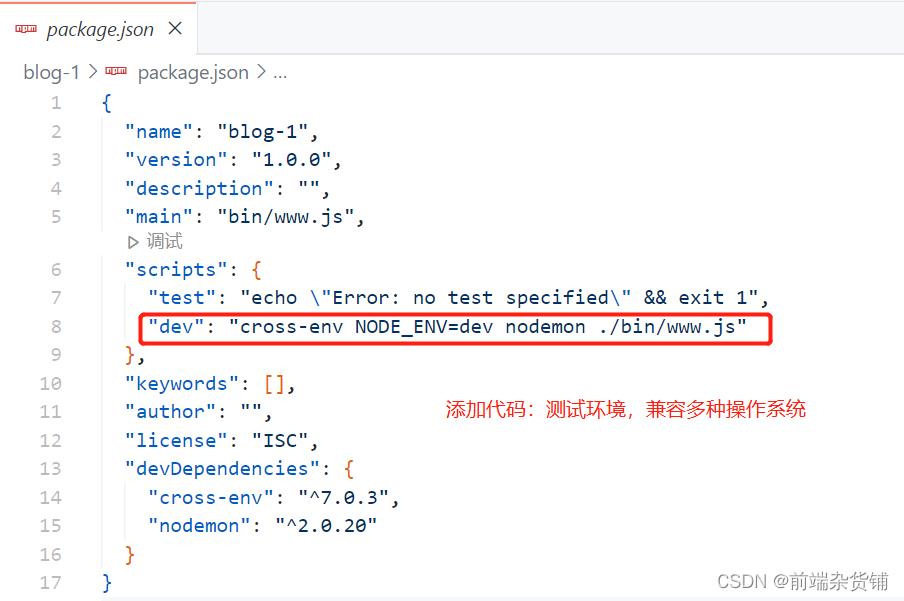
3、开发接口
博客相关接口 && 用户相关接口

4、开发过程
./bin/www.js 文件
- 项目执行的文件
- 引入 http 模块
- 创建服务,传入文件(易开发和维护)
- 监听端口
// 引入 http 内置模块
const http = require('http')
// 端口
const PORT = 8000
// 引入 app.js
const serverHandle = require('../app')
// 创建服务
const server = http.createServer(serverHandle)
// 监听端口
server.listen(PORT)
…/src/app.js 文件
- 参数处理
- 响应头
- 格式化
- 处理博客和用户的相关路由
// 便于处理 url
const querystring = require('node:querystring')
// 博客相关路由
const handleBlogRouter = require('./src/router/blog')
// 用户登录相关路由
const handleUserRouter = require('./src/router/user')
// 用于处理 POST 请求的数据
const getPostData = (req) =>
// 创建 promise 实例
const promise = new Promise((resolve, reject) =>
// 不是 post 请求 直接返回
if (req.method !== 'POST')
resolve()
return
// 请求头不是 application/json 格式 直接返回
if (req.headers['content-type'] !== 'application/json')
resolve()
return
// 初始化 postData
let postData = ''
// 每次发送的数据 记录在 postData 中
req.on('data', chunk =>
postData += chunk.toString()
)
// 数据发送完成 转义 JSON 为对象
req.on('end', () =>
if (!postData)
resolve()
return
resolve(
JSON.parse(postData)
)
)
)
// 返回实例对象
return promise
// 处理服务
const serverHandle = (req, res) =>
// 设置响应头的格式 JSON
res.setHeader('Content-type', 'application/json')
// 获取请求地址 path
const url = req.url
// 截取前半部分的地址 ? 前面的部分
req.path = url.split('?')[0] // 获取 ? 的前半部分
// 截取后半部分的地址 ? 后面的部分 也是要查询的地址
req.query = querystring.parse(url.split('?')[1])
// 处理 post data
getPostData(req).then(postData =>
// 解析 POST 请求中的数据
req.body = postData
// 处理 blog 路由
const blogData = handleBlogRouter(req, res)
// 请求成功 格式化 blogData 并结束
if (blogData)
res.end(
JSON.stringify(blogData)
)
return
// 处理 user 路由
const userData = handleUserRouter(req, res)
// 请求成功 格式化 userData 并结束
if (userData)
res.end(
JSON.stringify(userData)
)
return
// 未命中路由,返回 404
res.writeHead(404,
"Content-type": "text/plain"
)
// 在浏览器显示的内容
res.write("404 Not Found\\n")
// 结束服务端和客户端的连接
res.end()
)
// 模块化 把 serverHandle 暴露出去
module.exports = serverHandle
…/src/model/resModel.js 文件
- 基础模型(对象类型和字符串类型)
- 成功的模型(继承)
- 失败的模型(继承)
// 基础模型
class BaseModel
// data 是对象类型 message 是字符串类型
constructor(data, message)
if (typeof data === 'string')
this.message = data
data = null
message = null
if (data)
this.data = data
if (message)
this.message = message
// 成功模型 errno 赋值 0
class SuccessModel extends BaseModel
constructor(data, message)
// 继承父类
super(data, message)
// 成功的值 0
this.errno = 0
// 失败模型 errno 赋值 -1
class ErrorModel extends BaseModel
constructor(data, message)
// 继承父类
super(data, message)
// 失败的值 -1
this.errno = -1
// 导出共享
module.exports =
SuccessModel,
ErrorModel
…/src/router/blog.js 文件
- 博客相关路由接口
- 调用相关函数
- 返回实例
// 导入博客和用户控制器相关内容
const getList, getDetail, newBlog, updateBlog, delBlog = require('../controller/blog')
// 导入成功和失败的模型
const SuccessModel, ErrorModel = require('../model/resModel')
// blog 路由
const handleBlogRouter = (req, res) =>
const method = req.method // GET/POST
const id = req.query.id // 获取 id
// 获取博客列表 GET 请求·
if (method === 'GET' && req.path === '/api/blog/list')
// 博客的作者 req.query 用在 GET 请求中
const author = req.query.author || ''
// 博客的关键字
const keyword = req.query.keyword || ''
// 执行函数 获取博客列表数据
const listData = getList(author, keyword)
// 创建并返回成功模型的实例对象
return new SuccessModel(listData)
// 获取博客详情 GET 请求
if (method === 'GET' && req.path === '/api/blog/detail')
// 获取博客详情数据
const data = getDetail(id)
// 创建并返回成功模型的实例对象
return new SuccessModel(data)
// 新建一篇博客 POST 请求
if (method === 'POST' && req.path === '/api/blog/new')
// req.body 用于获取请求中的数据(用在 POST 请求中)
const data = newBlog(req.body)
// 创建并返回成功模型的实例对象
return new SuccessModel(data)
// 更新一篇博客
if (method === 'POST' && req.path === '/api/blog/update')
// 传递两个参数 id 和 req.body
const result = updateBlog(id, req.body)
if (result)
return new SuccessModel()
else
return new ErrorModel('更新博客失败')
// 删除一篇博客
if (method === 'POST' && req.path === '/api/blog/delete')
const result = delBlog(id)
if (result)
return new SuccessModel()
else
return new ErrorModel('删除博客失败')
// 导出
module.exports = handleBlogRouter
…/src/router/user.js 文件
- 博客相关路由接口
- 调用相关函数
- 返回实例
// 导入用户登录内容
const loginCheck = require('../controller/user')
// 导入成功和失败的模板
const SuccessModel, ErrorModel = require('../model/resModel')
// user 路由
const handleUserRouter = (req, res) =>
const method = req.method
// 登录
if (method === 'POST' && req.path === '/api/user/login')
const username, password = req.body
// 传入两个参数 用户名 密码
const result = loginCheck(username, password)
if (result)
return new SuccessModel()
return new ErrorModel('登录失败')
// 导出共享
module.exports = handleUserRouter
…/src/controller/blog.js 文件
- 博客的相关数据处理
- 返回的是假数据(后续会使用数据库)
// 获取博客列表(通过作者和关键字)
const getList = (author, keyword) =>
// 先返回假数据(格式是正确的)
return [
id: 1,
title: '标题1',
content: '内容1',
createTime: 1665832332896,
author: 'zahuopu'
,
id: 1,
title: '标题2',
content: '内容2',
createTime: 1665832418727,
author: 'xiaoming'
,
]
// 获取博客详情(通过 id)
const getDetail = (id) =>
// 先返回假数据
return
id: 1,
title: '标题1',
content: '内容1',
createTime: 1665832332896,
author: 'zahuopu'
// 新建博客 newBlog 若没有,就给它一个空对象
const newBlog = (blogData = ) =>
// blogData 是一个博客对象 包含 title content 属性
console.log('newBlog', blogData)
return
id: 3 // 表示新建博客,插入到数据表里的 id
// 更新博客(通过 id 更新)
const updateBlog = (id, blogData = ) =>
// id 就是要更新博客的 id
// blogData 是一个博客对象 包含 title content 属性
console.log('update blog', id, blogData)
return true
// 删除博客(通过 id 删除)
const delBlog = (id) =>
return true
// 导出共享
module.exports =
getList,
getDetail,
newBlog,
updateBlog,
delBlog
…/src/controller/user.js 文件
- 用户登录的相关数据处理
- 返回的是假数据(后续会使用数据库)
// 登录(通过用户名和密码)
const loginCheck = (username, password) =>
// 先使用假数据
if (username === 'zahuopu' && password === '123')
return true
return false
// 导出共享
module.exports =
loginCheck
三、各个接口的测试
现在我们 已经完成 博客项目的开发了,接下来进入到 测试环节~~
通过关键字和作者 查询博客(GET 请求)

通过 id 获取 博客详情(GET 请求)

通过 ApiPost/Postman 工具测试 新增博客(POST 请求)
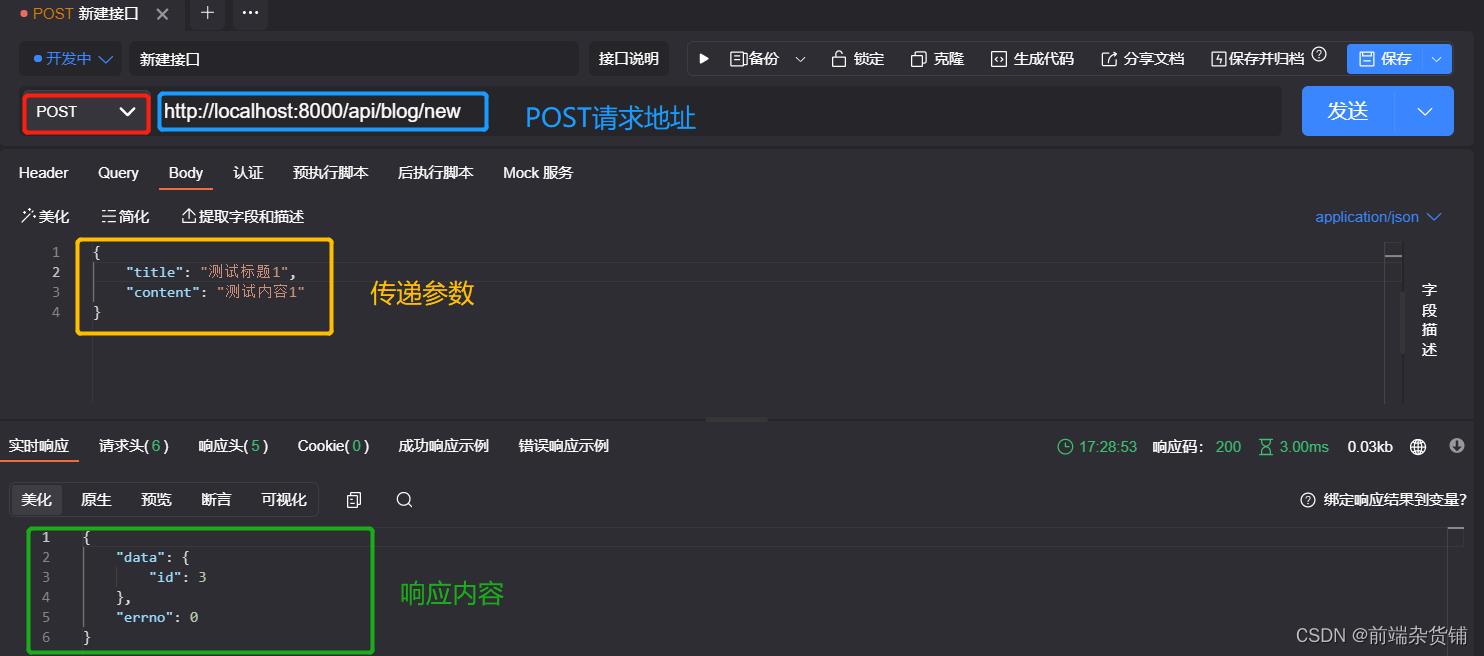
通过 ApiPost/Postman 工具测试 更新博客(POST 请求)
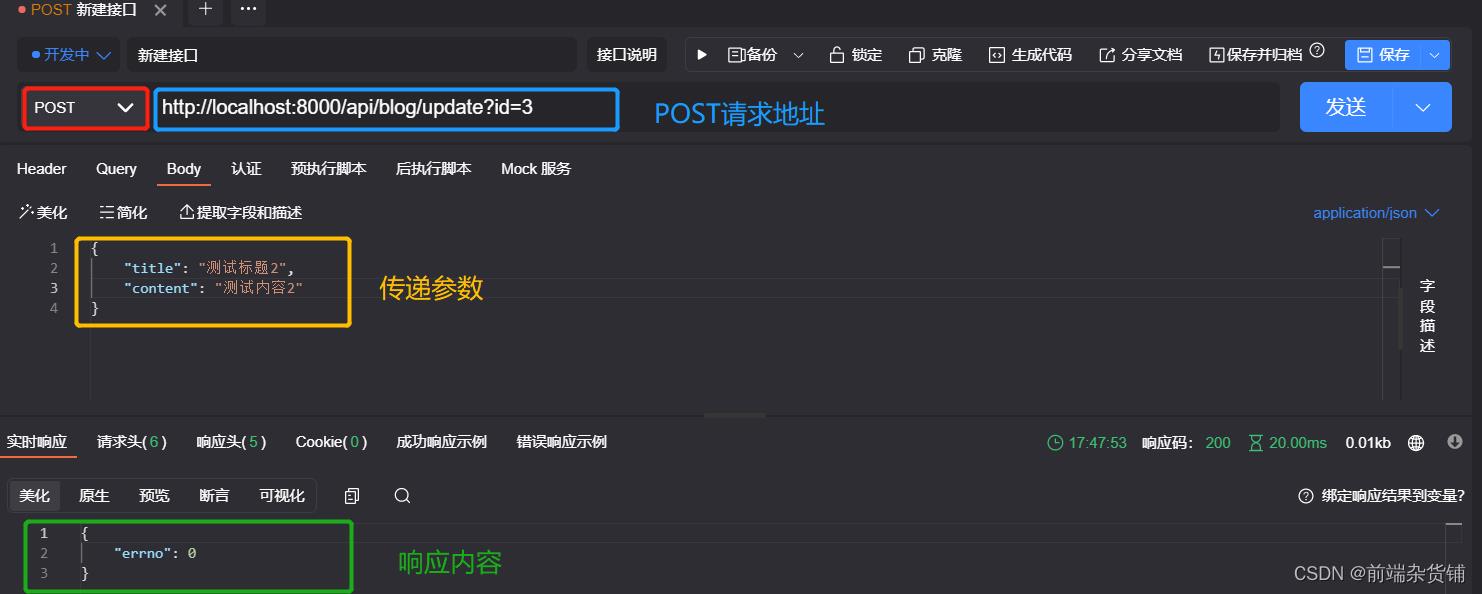

通过 ApiPost/Postman 工具测试 删除博客(POST 请求)
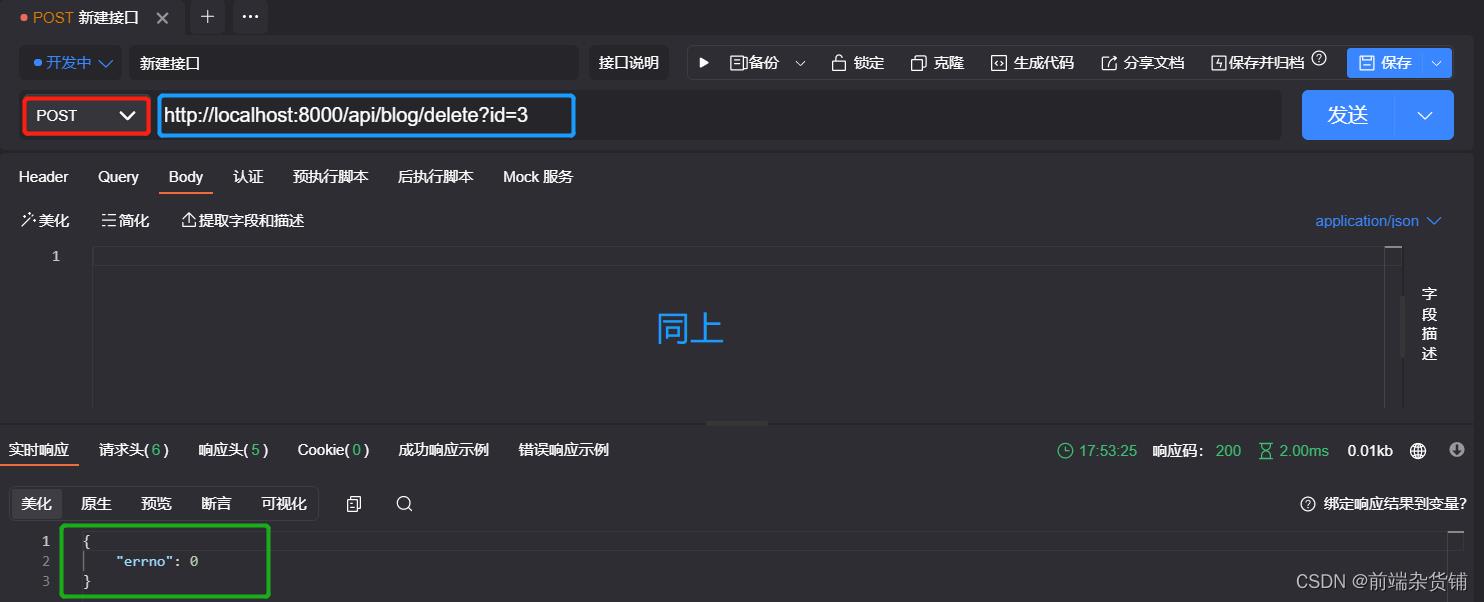
通过 ApiPost/Postman 工具测试 登录请求(POST 请求)


四、写在最后(附源码)
至此,开发博客的项目(假数据版,并没有使用数据库)就完成了。
后续会对该项目进行多次重构【多种框架(express,koa)和数据库(mysql,sequelize,mongodb)】
如果你需要该项目的 源码,请通过本篇文章最下面的方式 加入 进来~~

以上是关于Node.js实战一文带你开发博客项目(API 对接 MySQL)的主要内容,如果未能解决你的问题,请参考以下文章